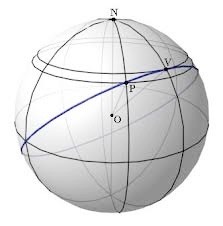
1 It is reported that sunset(s) in Wallsend and Newcastle are four minutes apart. Can this be right?
a Find what distance you expect for a difference of four minutes in sunset on the equator.
b Find the distance you expect for a difference of four minutes in sunset at latitude 51º
c Taking the distance as five miles along an east-west line, find the time difference you would expect.
2 Two other places on similar latitudes and in the same country are Chengdu [30.67ºN, 104.07º] and Hangzhou [30.25,120.17]. take these as being at 30ºN and the longitudes as 104 and 120º.
a Using an equator of 40 thousand kilometres, check that you think the distance between cities along the line of latitude is 1540km.
b Find the speed of the dawn line, the apparent surface speed at 30ºN.
c Find the time between sunsets for these two cities.
3 Britain moved to Summer Time (to ‘spring forward’ to UTC+1) on 29/3/2015, in line with most of Europe. New Zealand changed the other way (to ‘fall back’ to NZST, UTC+12) on April 5th. In winter the UK standard time, GMT, is at UTC+0 and in winter NZ is at NZST, UTC+12.
What is the time difference between UK and NZ on (i) March 1st (ii) April 1st (iii) May 1st ?
4 Calculation of the shortest distance between two points on a sphere (e.g. our planet) calls for understanding of a ‘great circle’. Two points are located by (latitude, longitude). Let these locations be (ϕ1, λ1), (ϕ2, λ2); then the angle between them at the centre, θ, has the relationship
cos θ = sin ϕ1 sin ϕ2 + cos ϕ1 cos ϕ2 cos (λ2- λ1) and the arc length is Rθ (in radians) or 2πRθ/360 in degrees.
a Use this formula to find the great circle distance between Chengdu and Hangzhou (Q2), which won’t be much different from the previous result because the latitudes are so similar.
b Find the great circle distance from Newcastle upon Tyne at (55, -1.5) to Newcastle, NSW at (-33N, 151.5).
c Find the centre angle for Qingdao (36, 120) and Buenos Aires (-34.5, -58.5).
d Find the centre angle for Stanley (-51.6, -58.0).and Mohe (52.4, 122.0). Mohe lies on the Amur river where it borders Russia and is the northernmost town in China. Stanley is the capital of the Falkland Islands, where the Chinese fleet may have reached. See 1421 by Gavin Menzies.
e A small (20km2) rocky island called Antipodes island belonging to New Zealand lies at (-49.7±0.2, 178.8±0.1). Its exact antipodes would be at (+49.7±0.2, 0.2±0.1). Find the largest town (if any exist) that falls inside this area.
DJS 20150329
The formula given in Q4 is unstable if used in software—the function inverse cosine is ‘ill-conditioned’—for small angles it is ‘unreliable’, meaning that small differences on one side of the function make for large differences on the other. A modern calculator may be immune to this effect. Users wishing to write a spreadsheet to play with this are directed to the Haversine formula, which is stable.
Challenge: using points within the conurbation of any large city, can you find:
i) two well-known cities mutually at right angles (at the centre of the earth)
ii) three well-known cities mutually at right angles
iii) three cities where any two are at the same centre angle
iv) the largest number of such places and suggest a solution set.
1a 40 million metres of equator rotating every 24 hours gives 463 m/sec. So 4 minutes => 111km
b the radius of the circle shrinks by a multiplier of cos51º. So the surface speed is 290 m/sec and four minutes represents 70km, more like Newcastle to Brampton.
c 5 miles is 8km, which at 290m/sec is 27 seconds.
Using Google, today sunset in Newcastle and Wallsend will be 19:36 and in Carlisle will be at 19:42.
TimeAndDate says 19:37 and 19:42. Sunrise-and-sunset agrees. 5 minutes (4.5 to 5.5 puts the distance between Newcastle and Carlisle as 78 and 96km which is about right.
2a Distance between them along the line of latitude is (16/360)*40000*cos30º) = 1540 which checks well with mapcrow.info.
b The apparent surface speed is, at 30ºN, 463*cos30=401m/sec
c Since they are 16 degrees apart, you expect this to be 16/360 of a day, 64 minutes. Using 1540/401 we have the same answer to 3s.f., 3840 secs=64 minutes
3 +13 (0,+13), +12 (+1,+13), +11 (+1,+12) hours going from British time to NZ time. Look this up here. Read about time zone differences in Essay 97.
4a I get cos θ = 0.9708, θ=13.87º, arc length 40000*13.87/360 = 1541.4. Compare this with 16.1º at latitude 30.46º, 1542.0 to 4sf.
b The points given are within each conurbation. cos θ = -0.87475, θ=151º (less than I expected), arc length 40000*151/360 = 16780km to 4sf.
c 178º. Very nearly polar opposites.
d 179.2º This follows from looking where in the world lie the antipodes to China.
e Le Havre lies at (49.5±.05, 0.2±0.2). You are right; that is not in the UK.
Challenge—I have no good idea as yet. My instant thought is that the upper limit is four, as if the vertices of a tetrahedron, so the common angle is around 105º (instinctively I think cos-1 (-0.25)).
London, Capetown and Quito are all between 85 and 95º of each other.
London and Phnom Penh are 90º apart. Capetown is within 5º of right angles to both.
Looking for 105º, London is at the 105º to Jakarta, Santiago and Honolulu but their common angles don’t fit.